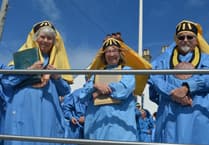CROWNED by Sir John Betjeman as Cornwall’s ‘most unspoiled’ church, St Swithin’s Church at Launcells has a rich history tracing back to the late 15th century.
The church includes features of a 14th century structure allowing the building to retain historical charm and architectural integrity.
Today is St Swithin’s Day, so let's take a closer look at this very special St Swithin’s building in Launcells.
Another building of the village dates back to its mention in the Domesday Book of 1085. Launcells Church, first documented around 1200 when it was assigned to the Abbey of Hartland, displays an early Norman font. Originally dedicated to St Andrew, the church was later rededicated to St Swithin in 1321.
In the 15th century, the church experienced a reconstruction, where the granite north arcade slightly following the south arcade, crafted from Polyphant stone. The porch maintains its original seating and holy water stoup, while the windows feature vertical lattice and age-old clear glass.
Impressively the original wagon roofs remain, preserved from the 15th century, decorated with intricately carved wall plates, purlins, and bosses, while the stairway to the former roof loft resides in the north aisle. Another 15th century feature is the Barnstaple encaustic tiles which cover the floors.
A striking wall painting, recently conserved, depicts Abraham and Isaac in Tudor Costume on the west wall, hinting at potential further paintings concealed beneath the plaster.
Adding to the fascinating artistry of the church's history are the Royal Coat of Arms of Charles II and six bells, the oldest of which is dated 1751. There are also Georgian influences evident in the pulpit, tester, and box pews on the north side. In the churchyard, three listed chest tombs, ranging from the late 16th to mid-18th century, further enrich the historical tapestry of Launcells Church.
Any visitor should be prepared to be enchanted by the location of the church, nestled in a serene valley, surrounded by a charming bridge and a murmuring stream. he revered Holy Well, believed to possess endless waters, adds an air of mystique to the setting. Moreover, the carefully tended graveyard boasts a special conservation area that is dedicated to promoting the growth of insects and flora. As if that wasn't intriguing enough, the final resting place of Sir Goldsworthy Gurney, the ingenious inventor of Limelight, further enriches the site's historical charm.
Not only are the surrounding areas a sight to behold but the church's interior is washed in natural light flowing through its clear glass windows, showcasing its distinctive architectural elements.





Comments
This article has no comments yet. Be the first to leave a comment.